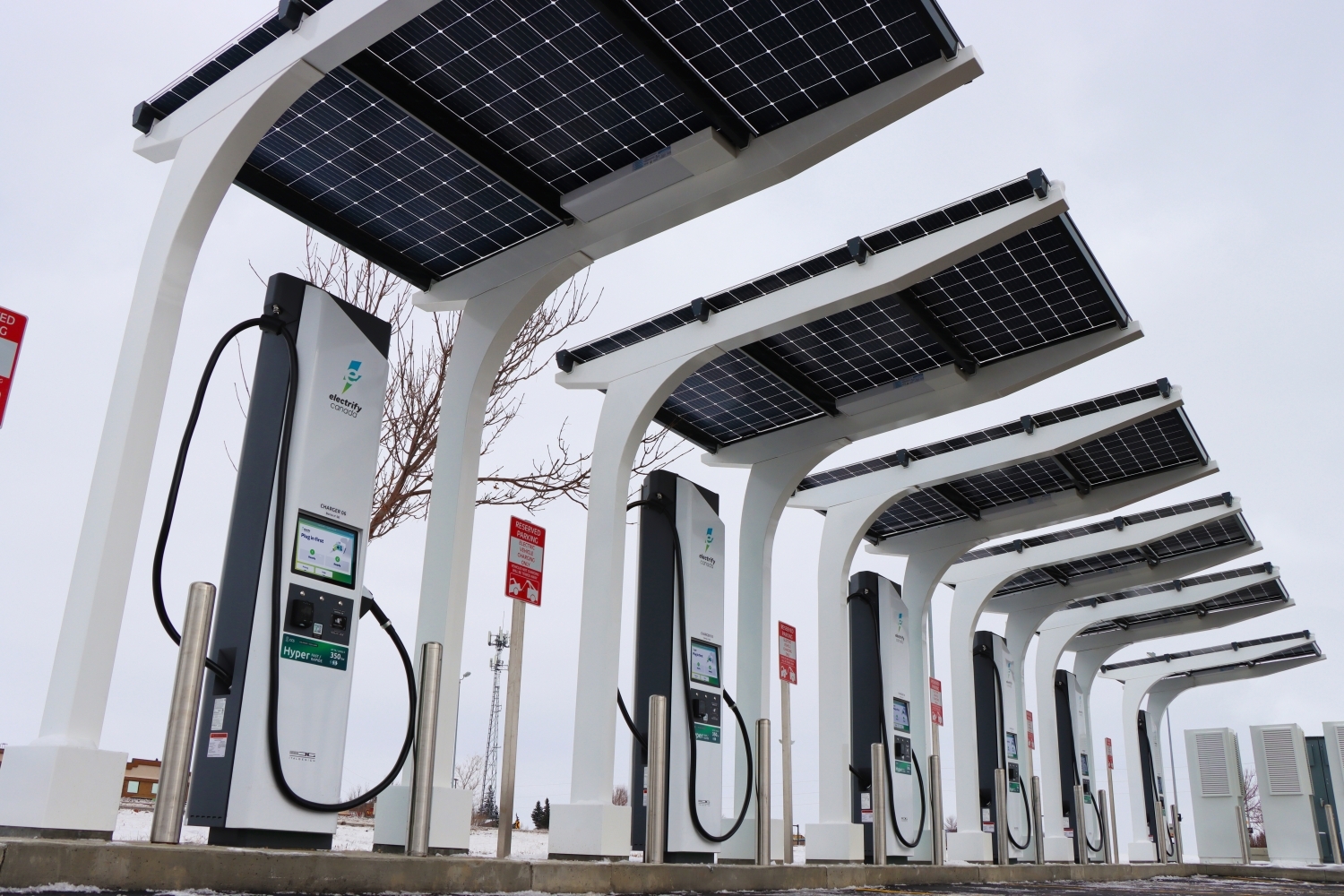
Here Electrify Canada chargers are at the ready in Regina, Sask.
Canada has finalized its new Electric Vehicle Availability Standard, mandating 100% ZEV sales by 2035, with industry groups sounding alarms.
The national target of 100 percent zero-emission vehicle sales by 2035 is joined by interim targets of at least 20 percent of all sales by 2026 (effectively almost double current levels), and at least 60 percent by 2030.
According to the Government, this will channel supply to Canadian markets instead of going abroad, reducing customer wait times and making sure Canadians have access to the latest affordable and technologically advanced vehicles that are coming to the market in the next few years.
“The Electric Vehicle Availability Standard helps Canada keep pace with the United States, the United Kingdom, the European Union, and several other major economies which are all taking action to lower emissions and put more electric vehicles on the roads,” reads the statement.
“The Standard complements additional actions underway by the federal government to develop a robust electric vehicle supply chain and infrastructure that creates good, middle-class jobs and ensures a cleaner, safer environment.”
Automaker and car dealers groups pre-emptively pushed back on the anticipated announcement: “Regulating vehicle sales will make life even more unaffordable for Canadians,” said Brian Kingston, President & CEO, Canadian Vehicle Manufacturers’ Association. “Achieving 100% ZEV sales requires a comprehensive, long-term plan to support ZEV adoption that includes stronger consumer purchase incentives, a widespread public charging network, and enhancements to the electricity grid to prepare Canada for more ZEVs on the road.”
The Automotive Industries Association of Canada issued a statement that the transition will not be helped by the current practice of automakers restricting repair information:
“The Federal government’s announcement to transition to 100% electric vehicle sales by 2035 is not complete without preparing and supporting the automotive aftermarket to service, repair and maintain the vehicles of today and tomorrow,” said Alan Baker, VP Government Relations and Research for AIA Canada.
“Canada’s auto care sector, including Independent service and repair shops, play a critical role in keeping vehicles on our roads. Adoption of EVs in Canada is contingent on supporting an ecosystem where these vehicles can be readily repaired and serviced. This includes ensuring increased access to vehicle data for the purpose of service and repair. At present many automakers hold control of repair and service information on these vehicles, which can limit where consumers take their vehicle for repair. This eliminates competition in the market and will drive up cost for drivers who are looking to service their vehicle at a competitive price, close to home. Automakers themselves are already warning that a mandate to purchase electric vehicles with pose affordability issues for Canadians. If right to repair isn’t addressed, this will leave vehicle owners with only one option: to service their vehicles at the dealership and face higher costs.
“The aftermarket cannot be an afterthought. Ambitious targets to transition to EV sales must be accompanied by comprehensive right-to-repair legislation that will ensure third-party repair shops have timely access to essential vehicle data.”
According to Government of Canada information, the Canadian marketplace for passenger vehicles is already experiencing a rapid shift toward zero-emission vehicles, with one-in-eight new car sold being ZEVs, one in five in B.C. and Quebec.
In its announcement, the Government of Canada also said ZEVs are the most affordable option for Canadians in the long run:
- Recharging costs can be as little as $10 per 400 kilometres and, over a ten-year span;
- The average cumulative ownership cost of an electric vehicle hatchback is $48,943, whereas the gas-powered alternative is $82,515.
- When purchase incentives are included–federal government up to $5,000 and up to $7,000 in Quebec–many models hit a cost parity with gas vehicles within four years, and some in under a year.
- Advancements in battery technology have improved cold-weather performance and increased the range of many currently available models to over 400 kilometres, representing a substantial improvement from earlier models. Fully electric, plug-in hybrid, and fuel cell vehicles all offer consumers different options when looking to purchase a new vehicle. While about 80 percent of current electric vehicle owners choose to charge their vehicles at home, the Government of Canada is investing $1.2 billion to build 84,500 chargers across the country by 2029, which adds on to efforts by businesses and other governments to further expand the charging infrastructure across the country.
- The switch to electric vehicles is also significantly reducing harmful air pollution. Health Canada analysis indicates that overall, emissions from all on-road vehicles contribute to an estimated 1,200 premature deaths and millions of cases of non-fatal health outcomes every year, at a total estimated economic cost of $9.5 billion annually. The air quality benefits of switching to electric vehicles will be particularly important for the 40 percent of Canadians who live near busy roads and highways and are exposed to high levels of pollution.
The Standard was informed by extensive engagement over the last two years and follows a phased-in approach that allows for a gradual and orderly switch to a 100 per cent zero-emission future. More than $34 billion in new investments have been made by automotive and battery manufacturers since 2020, and are part of the shift to electric vehicle production and establishing a battery supply chain in Canada—which will create and maintain hundreds of thousands of good-paying jobs for Canadians in a modern automotive supply chain.
When combined with investments in charging infrastructure, and battery and automotive manufacturing, along with consumer purchase incentives on new electric vehicles, the new Electric Vehicle Availability Standard is one more part of a comprehensive plan to ensure that Canadians fully benefit from an electric-vehicle future.

0 Comments